HAL Id: inria-00606763
https://hal.inria.fr/inria-00606763
Submitted on 7 Jul 2011
HAL is a multi-disciplinary open access
archive for the deposit and dissemination of
sci-entific research documents, whether they are
pub-lished or not. The documents may come from
teaching and research institutions in France or
abroad, or from public or private research centers.
L’archive ouverte pluridisciplinaire HAL, est
destinée au dépôt et à la diffusion de documents
scientifiques de niveau recherche, publiés ou non,
émanant des établissements d’enseignement et de
recherche français ou étrangers, des laboratoires
publics ou privés.
Level of Detail Continuum for Huge Geometric Data
Florent Duguet, Carlos Henandez Esteban, George Drettakis, Francis Schmitt
To cite this version:
Florent Duguet, Carlos Henandez Esteban, George Drettakis, Francis Schmitt. Level of Detail
Contin-uum for Huge Geometric Data. SIGGRAPH ’05 ACM SIGGRAPH 2005 Posters, 2005, Los Angeles,
United States. �inria-00606763�
Level of Detail Continuum for Huge Geometric Data
Florent Duguet∗ GET/T´el´ecom Paris REVES/INRIA Carlos Hernandez† GET/T´el´ecom Paris George Drettakis‡ REVES/INRIA Francis Schmitt§ GET/T´el´ecom ParisFigure 1: Illustration of our approach. Left, the normals are diffused in the volume defining a guidance vector field. Middle, the distance field. Right, the interpolated distance field.
1
Introduction
We propose a unified solution for the creation of levels of detail on very large input data. We build a hierarchical signed distance func-tion in an octree around the data and use this hierarchy to generate a continuum of levels of detail. Our distance function construction, based on the Gradient Vector Flow and the Poisson equation, builds on multigrid resolution algorithms. Using an appropriate interpolation scheme within the octree we obtain a continuous hierarchical distance function, which allows us to define a continuum of levels of detail for huge geometries. During this process, holes and undersampling issues in the input data are automatically corrected. We present three applica-tions of our hierarchy: a novel hierarchical deformable model scheme that can automatically reconstruct closed Eulerian meshes of up to a million faces in a few minutes, an alternate distance-driven contouring approach, and raytracing of huge data models.
2
Exposition
To construct levels of detail using previous techniques, it is neces-sary to combine several different approaches, and to perform three distinct steps. First, an object reconstruction step [Curless and Levoy 1996], followed by a hole filling phase [Davis et al. 2002], and finally a mesh simplification process [Hoppe 1996; Garland and Heckbert 1997]. This three-step approach is cumbersome and costly since the maximal resolution object needs to be built first, and holes at this scale need to be filled.
We propose a unified solution to the creation of a scale space on very large data. We build a signed distance function, which we extend to a large volume around the object, arranged in an octree. The signed na-ture of this function enables us to easily perform automatic hole-filling and address undersampling issues in the input data. This distance is computed using well known partial differential equations (PDE): the heat and Poisson equations.
Figure 1 illustrates the overview of our approach. First, we build a constrained octree using the input point and normal samples. Second, we diffuse the normals using a Gradient Vector Flow approach such that a smooth vector field is defined in the entire volume around the object. Finally, we extract the potential from this vector field by solv-ing a Poisson equation in the octree. This results in a smooth distance field defined at each cell of the octree. We interpolate node values to provide a smooth distance field in the entire volume around the object. This distance field is made hierarchical using node values. The tinuum is defined by interpolating the distance functions of two con-secutive clamping levels for the octree. We finally use parametric de-formable models (snakes) guided by the hierarchical distance field and
∗e-mail: Florent.Duguet@sophia.inria.fr †e-mail: Carlos.Hernandez@enst.fr ‡e-mail: George.Drettakis@sophia.inria.fr §e-mail: Francis.Schmitt@enst.fr
(a) (b)
Figure 2: Left, ray-traced image of the dancers model (47 million input points, image resolution: 1670x3400). Right, the reconstruction of the St.Matthew model using the hierarchical snake algorithm (370 million input points, 1 million triangles).
the guidance vector, improving convergence of previous approaches [Hernandez and Schmitt 2004] by a factor of 100. With this approach, we can build several representations of the same object of increasing complexity very efficiently (about four minutes to build a mesh of 1 million triangles for the St.Matthew model, after distance field con-struction of 1h40). Results are shown in figure 2.
3
Conclusion
We have presented an algorithm to generate a hierarchical distance function from points and normals. This distance function is continu-ous, with a continuous gradient, allowing the definition of a continuum of levels of detail. Three applications of our approach are presented: a fast hierarchical surface reconstruction algorithm using deformable models, a distance-driven dual contouring algorithm, and ray-tracing of huge point sets. Since our distance function is signed, any hole or undersampling issue in the input data is automatically corrected. Re-constructed meshes are thus hole-free.
Acknowledgements Data sets thanks to the Digital Michelangelo Project, and Stanford 3D Repository. The dancers column data has been acquired by an Electricit´e de France R&D project lead by Guil-laume Thibault, involving the Ecole Franc¸aise d’Ath`enes, the Ecole du Louvre, and Insight. Thanks also to ACI MD SHOW.
References
CURLESS, B.,ANDLEVOY, M. 1996. A volumetric method for build-ing complex models from range images. In Proc. of SIGGRAPH’96, ACM Press / ACM SIGGRAPH, ACM.
DAVIS, J., MARSHNER, S. R., GARR, M., ANDLEVOY, M. 2002. Filling holes in complex surfaces using volumetric diffusion. In Symposium on 3D Data Processing, Visualization and Trans. GARLAND, M., ANDHECKBERT, P. S. 1997. Surface
simplifica-tion using quadric error metrics. In SIGGRAPH 2000 Proceedings, ACM, 209–216.
HERNANDEZ, C.,ANDSCHMITT, F. 2004. Silhoutte and stereo fu-sion for 3d object modeling. CVIU 96, 3, 367–392.
HOPPE, H. 1996. Progressive meshes. In SIGGRAPH’96 Proceed-ings, ACM, 99–108.
